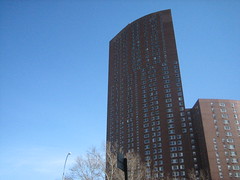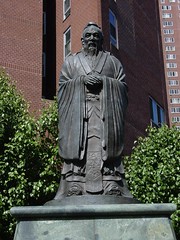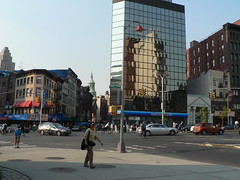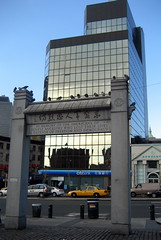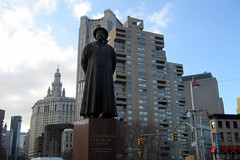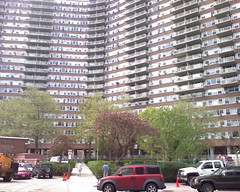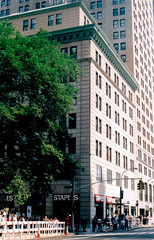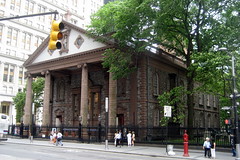West:
128 (block): Metropolitan
Correctional Center, a 1974 building by
Gruzen & Partners that provides holding
cells for the U.S. Courthouse.
The Hip Sing tong had a gambling den at
this address in 1906.
122: A connecting building.
100 (corner): Another branch of the
Metropolitan Correctional Center.
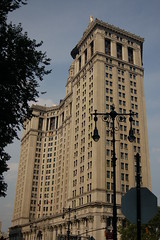
New York City launched an architectural
competition in 1907 to build an administrative
center for the newly consolidated five buroughs.
The winning design, by McKim, Mead & White,
mixed Imperial Roman and Renaissance motifs; it
was the firm's first skyscraper.

The distinctive
tower rising above the building's U-shaped base
is topped by Adolph Weinman's 20-foot-tall copper-clad
statue of Civic Fame--the largest statue in
New York after Liberty. Allegorical friezes
representing Civic Duty and Civic Pride
adorn the western facade. Stalin was a fan of the
building and had Moscow University's main building
patterned after it.
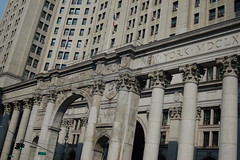
With a million square foot of space, the
building houses most of the Mayor's Office, as well as
those of the Manhattan Borough President, the Public
Advocate, the Comptroller and the Landmarks Preservation
Commission. It's where minimalists and couples in a
hurry go to get married--14,000 times a year. It's
also the home of
WNYC, New York's public radio station
since 1922--now broadcast from the tower.
|
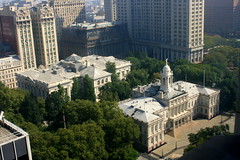
This was originally set aside in 1686 by the Dutch
colonial government as The Commons, a pasture
adjacent to the Collect Pond where townsfolk
could take their livestock to eat and drink.
It soon became the city's main park, serving as a gathering place
for celebrations--and protests.
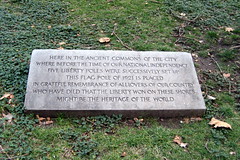
On August 11, 1766, New Yorkers angry that their Liberty
Pole protest in the park had been taken down, threw bricks
at British soldiers here, who retaliated with
bayonets--resulting in the first (non-fatal) bloodshed of
the Revolutionary era. General George Washington
had the Declaration of Independence read here
on July 9, 1776. In 1826, African-Americans rioted here
against slave-catchers pursuing escapees
from the South. Another riot here in 1837 opposed
the raising of the price of flour from
$6 to $15 a barrel. During the Draft Riots of 1863,
rioters attacked blacks here.
When Albany in 1857 replaced the corrupt
Municipal Police with a new organization known as
the Metropolitan Police, the two forces clashed
here in a
melee that left one officer permanently
crippled. Closer to the present, police
rioted here in September 1992 against Mayor David Dinkins'
Civilian Complaint Review Board proposals.
When author
Jack London was homeless for a time,
he spent his nights in City Hall Park--
a time that inspired his novel The
People of the Abyss.
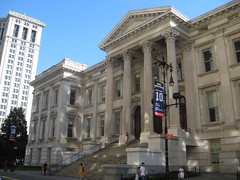
52 Chambers: Built between 1861 and 1871, this former
Criminal Courts Building was supposed to cost
$250,000; it ended up costing as much as $14 million,
with much of the difference being pocketed by William
''Boss'' Tweed and his Tammany Hall cronies. This
graft, excessive even for those days, helped land
Tweed in jail, but it is a remarkably beautiful
building.
This site was earlier the New York Institution, the
city's almshouse; the residents were transferred to
Bellevue in 1816, after which the building served to
house the New-York Historical Society, the Society Library,
the American Academy of Fine Arts and the Bank for Savings.

This has been called the city's ''greatest
architectural treasure''--I wouldn't go that far,
but it is pretty nice.
Built in 1811 to a design by John McComb and Joseph
Mangin, it was originally faced with marble on three
sides and brownstone on the north--because nobody
important lived north of City Hall in those days.
By 1954, the marble was decaying, and the entire
building was refaced with limestone.
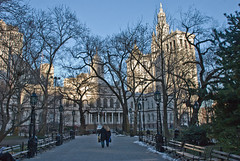
Abraham Lincoln lay in state in City Hall's rotunda
on April 24-25, 1865. Other prominent citizens
who have received the same honor include President
Grant and editor Horace Greeley.
Horace Greeley Statue
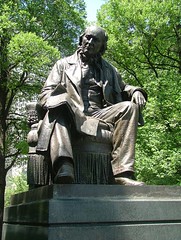 Though
Horace Greeley, the founder of
the New York Tribune, is chiefly remembered
as the guy who said "Go west, young man" (which
was not actually his line), Greeley
was actually one of the most influential journalists
in American history.
Though
Horace Greeley, the founder of
the New York Tribune, is chiefly remembered
as the guy who said "Go west, young man" (which
was not actually his line), Greeley
was actually one of the most influential journalists
in American history.
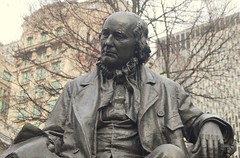
An advocate of social
reform (Karl Marx was a European correspodent),
Greeley supported abolition, worker's rights and
(yes) Western settlement. As a reporter covering
Congress in 1855, he was given a concussion by the
cane of pro-slavery House Speaker Albert Rust.
He helped found the Republican Party and was
instrumental in making Abraham Lincoln the
1860 candidate. Surprisingly, he was the 1872 Democratic
candidate for president; he was trounced by U.S. Grant
and died a month later.
The statue, by John Quincy Adams Ward, was cast
in 1890 and was placed across Park Row in front
of the Tribune Building until it was moved here in
1916. Its base is by Richard Morris Hunt.

When the
Croton Reservoir finally brought
a safe and reliable water supply to New York
City in 1842, a fountain fed by the reservoir
was opened here to mark the accomplishment. This
particular fountain was designed by Jacob Wrey Mould
in 1871, and originally stood in front of the Mullet
Post Office (see below). When efforts to tear down that
building were underway, the fountain was shipped to the Bronx's
Crotona Park in 1920. As part of his efforts to beautify
City Hall Park, Mayor Rudolph Giuliani had the fountain
brought back, replacing a Delacorte Fountain that had
been installed in the 1970s. It's fitting that one of
Giuliani's few genuine accomplishments was making the
park that surrounded his office look really nice.
The southern end of City Hall Park used to
be occupied by the Mullett Post Office--named
for architect Alfred Mullett. The 1878 Second Empire
building was considered an eyesore and demolished
in 1939; it looks a lot better to modern eyes,
gracing the cover of one popular New York
architectural guide.
|
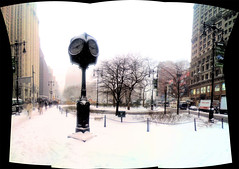
Millennium Park is a nicely landscaped traffic island.
|
|
|
East:
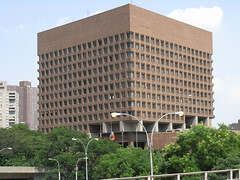 The headquarters of the NYPD, which moved here
in 1973 to replace the old
Police Building on Centre Street. Designed by
Gruzen and Partners in a Brutalist style.
The headquarters of the NYPD, which moved here
in 1973 to replace the old
Police Building on Centre Street. Designed by
Gruzen and Partners in a Brutalist style.
Near the southeast corner of the
building is a memorial to Revolutionary War POWs
that incorporates a window from the
Rhinelander Sugar House,
built in 1763 and demolished in 1892.
Because of their thick walls and
small windows, sugar warehouses
were used by the British to hold
prisoners--with deadly results--though the Rhinelander
building's use for this purpose is actually
disputed.

Construction on the bridge began in 1870; when
completed in 1883, it was half again as long as any
other suspension bridge in the world. At least 16
people died in its construction, including its
architect,
John Augustus Roebling, who contracted
tetanus after his foot was crushed by a ferry. His son
Washington Roebling, who inherited the project,
was stricken by compression sickness while working in
cassions, leaving Washington's wife
Elizabeth Warren Roebling
to become the de facto chief engineer.

Soon after it was opened, on Memorial Day 1883,
a panic on the bridge resulted in a dozen people being
trampled to death.
Con artists actually have succeeded in
repeatedly selling the Brooklyn
Bridge to gullible victims.
53-63 (corner): This was the location
of the
New York World Building, also
known as the Pulitzer Building, designed by
George B. Post and built
by Joseph Pulitzer in 1890 to house his flagship
newspaper. Pulitzer's office was in the distinctive
rooftop dome, which at 309 feet was the
first structure to surpass the height
of Trinity Church's steeple.
Demolished in 1955 to expand the Brooklyn Bridge
approach.
|
Printing House Square
This open space, separated by a traffic-free
Nassau Street from Pace University Plaza,
commemorates the era when New York's many
daily newspapers were based on what was
known as Newspaper Row--conveniently close
to both City Hall and the financial district
in the days before telephones or rapid transit.

This sculpture of
Benjamin Franklin, by
Ernst Plassman, commemorates his role as publisher;
he holds a copy of his Pennsylvania Gazette. The
statue was dedicated in 1872 in a ceremony involving
Samuel Morse and Horace Greeley.
Near this spot on May 16, 1691,
Jacob Leisler
was executed for treason. Leisler, chief of
the city's militia, took over the colony in
1689, ostensibly because Gov. Francis Nicholson
hadn't recognized the replacement of King James II
by King William and Queen Mary. Leisler, however, refused
to step down when William and Mary sent their own
replacement governor, a political dispute
that turned into a low-level civil war and ended in
a treason conviction. He and his son-in-law
Jacob Milbourne were sentenced to be hanged,
disemboweled, burnt alive, beheaded and quartered.
Hester Street is named for his daughter.
|
Old New York Times Building
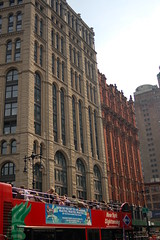
41 (corner):
The building that
houses the Pace University Bookstore (along
with other Pace offices and classrooms) was built
in 1857 as the headquarters of the New York
Times (founded in 1851). Designed by George B.
Post (the Stock Exchange's architect), its round arches,
recessed windows and rusticated stone place it in the
Romanesque Revival. The Times moved from here to
what is now Times Square in 1905, and Pace bought
the building in 1952.
Earlier this was the site of the Brick Presbyterian
Church, from 1766 until 1856. It was used by the
British as a prison and a hospital during the
American Revolution. In 1832 Baker &
Scribner Publishers also had their offices
on this lot; in 1810 it was the site of
the White Lecture Room. The Kine Pox
Institute was found here in 1802, as
was the volunteer firefighting unit Engine Co. No. 4.
In 1686, the home of Gov. Thomas Dongan, whose charter for New York
issued that year remains the basis
for the city's government. In 1646, this was the home of Cornelius
Van Tienhoven, a New Amsterdam official noted for
his accounting expertise and his involvement
in atrocities against the Indians.
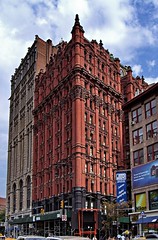
38 (corner):
A gorgeous red brick building
built 1883-86 with fantastic terra cotta detail.
Built by Orlando B. Potter to replace an
earlier building he owned that burned down
in 1881 (an event featured in the novel
Time After Time), he used terra cotta
in part for its fireproof qualities.
Potter's earlier building, completed in 1857,
was known as the World
Building, after the New York World
which was based there. (This was before Joseph
Pulitzer bought the paper.)
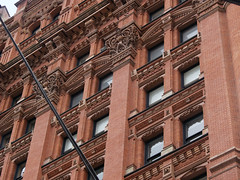 It also housed the
offices of Scientific American, where on
December 7, 1877, Thomas Edison gave the first
public demonstration of his phonograph.
N.G. Starkweather extensively used terra
cotta detail, helping to popularize the material
for office buildings; Potter later launched
the New York Press.
It also housed the
offices of Scientific American, where on
December 7, 1877, Thomas Edison gave the first
public demonstration of his phonograph.
N.G. Starkweather extensively used terra
cotta detail, helping to popularize the material
for office buildings; Potter later launched
the New York Press.
On the ground floor is Bondy's CDs &
Tapes.
|
|
34 (corner): A collection of electronics stores
that takes up most of this block, J & R has
a reputation as the place to go in New York
for the best prices. J and R are Joe and Rachelle
Friedman, a married couple who started the
company in 1971 with money they got as wedding presents.
This address houses the company's camera store.
33: J & R international music.
This was the first storefront for J & R
when it opened in 1971, originally specializing
in audio equipment and then branching out
into phonograph records. The
name "Thompson's" is carved on the building,
as this was once a
Thompson's cafeteria here;
the Chicago-based brand is considered the first
large, urban restaurant chain.
31: J & R audio/video. This building
used to be the
City Hall Theatre from c. 1919-39.
29: Weinstein & Holtzman Hardware,
est. 1920,
boasts of helping to build
everything from the Waldorf-Astoria
to Yankee Stadium.
27: J & R appliances
25: This was the address of the
Daily News, one of the few survivors
of Newspaper Row.
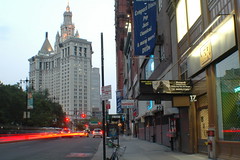
23: J & R music--pop and jazz.
The former address of the Mail and Express,
created when Cyrus Field merged the Evening
Mail and Evening Express.
21: The address of the New York Recorder.
20: The address of the Morning Advertiser.
19: J & R returns dept.
17: J & R personal care
15: At 30 stories and 391 feet,
this was the tallest building in
the world from 1899, when it was built by
a syndicate headed by August Belmont, until
1908, when it was eclipsed by the now-demolished
Singer Building.
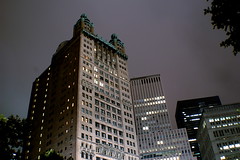 The design, by
R.H. Robertson,
was scorned by contemporary critics; it's
notable for the twin cupolas on its roofline
and the four heroic caryatids above the entrance.
The building housed Belmont's Interborough Rapid
Transit Company as well as the first offices
of the Associated Press, incorporated in 1900.
The design, by
R.H. Robertson,
was scorned by contemporary critics; it's
notable for the twin cupolas on its roofline
and the four heroic caryatids above the entrance.
The building housed Belmont's Interborough Rapid
Transit Company as well as the first offices
of the Associated Press, incorporated in 1900.
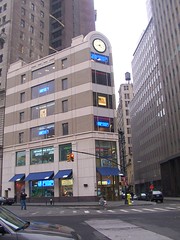
1 (corner): J & R Computer World
is perhaps the best-known branch of the store;
much of the Songlines were written on a J & R
computer. The name evokes the brilliant
Kraftwerk album.
|
|
